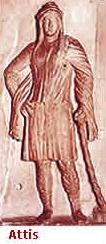
 |
|
The roots of Easter as a celebration of the Spring Equinox |
| Easter falls at the time of the spring equinox. This is no coincidence because the roots of Easter are neo-pagan. Easter has been known by many names: Ostra, Ostrara, Ostara, Eostre and Eastre. The Christian celebration of Easter is like an overlay-at one point in time, when the Christian religion incorporated the ancient Celtic and other pagan rituals. The roots are still there in a modern day Christian holiday. Easter can be celebrated anywhere from March 22 to April 25. This is because the early observation of Easter was determined by early churches to be on the first Sunday following the full moon that occurs on or following the spring equinox (March 21). |
 |
Symbols of Easter-the colored Easter egg, the rabbit, and the Easter lily are all part of the Easter holiday. These symbols all came from the celebrating the victory of spring over winter, of life over death, with rituals to the Gods and Goddesses. From celebrating the revival of nature and the return of the sun's warmth, Easter became the Christianized rebirth of mankind through Christ's death and resurrection. |
| Some Christians might like to deny the connection but the theme of rebirth and resurrection is part of many spring celebrations. Wiccans and other modern-day Neopagans continue to celebrate the Spring Equinox as one of their 8 yearly Sabbats (holy days of celebration). Near the Mediterranean, this is a time of sprouting of the summer's crop; farther north, it is the time for seeding. Their rituals at the Spring Equinox are related primarily to the fertility of the crops and to the balance of the day and night times. Where Wiccans can safely celebrate the Sabbat out of doors without threat of religious persecution, they often incorporate a bonfire into their rituals, jumping over the dying embers is believed to assure fertility of people and crops. |
| Many, perhaps most, Pagan religions in the Mediterranean area had a major seasonal day of religious celebration at or following the Spring Equinox. Cybele, the Phrygian fertility goddess, had a fictional consort who was believed to have been born via a virgin birth. He was Attis, who was believed to have died and been resurrected each year during the period MAR-22 to MAR-25. "About 200 B.C. mystery cults began to appear in Rome just as they had earlier in Greece. Most notable was the Cybele cult centered on Vatican hill ...Associated with the Cybele cult was that of her lover, Attis ([the older Tammuz, Osiris, Dionysus, or Orpheus under a new name). He was a god of ever-reviving vegetation. Born of a virgin, he died and was reborn annually. The festival began as a day of blood on Black Friday and culminated after three days in a day of rejoicing over the resurrection." |
 |
Many religious historians believe that the death and resurrection legends were first associated with Attis, many centuries before the birth of Jesus. They were simply grafted onto stories of Jesus' life in order to make Christian theology more acceptable to Pagans. Others suggest that many of the events in Jesus' life that were recorded in the gospels were lifted from the life of Krishna, the second person of the Hindu Trinity. Ancient Christians had an alternate explanation; they claimed that Satan had created counterfeit deities in advance of the coming of Christ in order to confuse humanity. Modern-day Christians generally regard the Attis legend as being a Pagan myth of little value. |
| They regard Jesus' death and resurrection account as being true, and unrelated to the earlier tradition. |
| A Jewish festival, Purim, also celebrated in the spring, has as it central character and heroine, Esther who, as queen, kept the evil Haman from killing her people. Even the very word moon derives from the Sanskrit mas or ma, meaning "to measure." |
 |
Easter is a wonderful admixture of ancient and modern.
This is to show respect for this Christian holiday,
|
| Select and click to link to each section: |
| Home | Occult, Paranormal | Dorian's Occult Site | Poetry, Haiku | Mysteries | Halloween | |